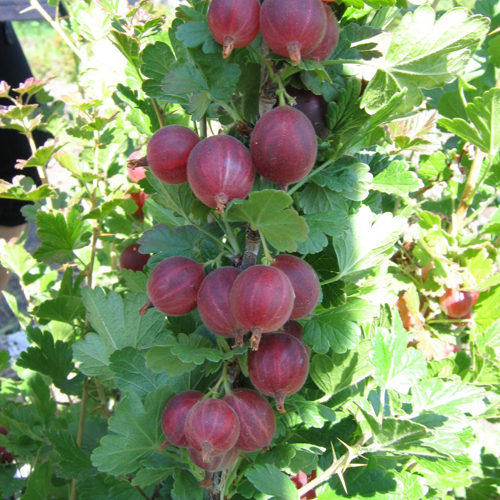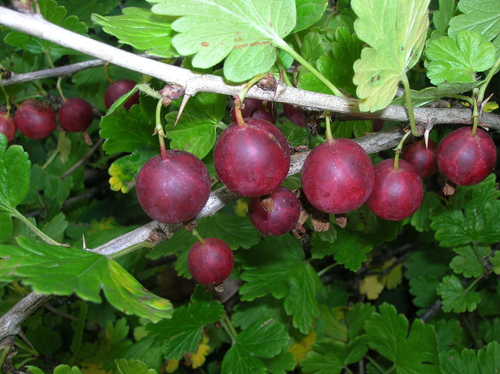Gooseberry variety Krasnoslavyansky
From the moment of its creation in the early 80s of the last century to the present day, Krasnoslavyansky gooseberry is considered a promising variety and is in high demand among gardeners, even despite the rather large number of thorns. It was received by O.A. Medvedeva and I. S Studenskaya from crossing the Oregon and Avenarius varieties. The birthplace of the novelty is the Leningrad Fruit and Vegetable Experimental Station. In 1992, the variety was included in the State Register of Breeding Achievements of Russia and received admission to cultivation in the North-West, Central and Volga-Vyatka regions. According to many gardeners, Krasnoslavyansky is one of the most delicious types of gooseberries.
Description
A medium-sized plant is represented by a slightly spreading, relatively compact bush of medium thickening. Height about 150 cm. Not too thick straight shoots grow upward and to the sides. The shoots are colored light brown at the base, and then, along the entire length, the color is light green. Medium to strong thorniness of the variety. Thorns are located along the entire length of the shoot, are of medium length and thickness, greenish-yellow in color, one-, two- and tripartite, sharp, straight, grow perpendicular to the shoot or slightly bent downward. Gooseberry buds are small, with a pointed top, brown, slightly deviated from the shoot.

The leaf of Krasnoslavyansky is wide-rounded, of normal size, green in color, smooth, slightly wrinkled, with a slightly shiny or matte surface. The upper side of the leaf is not pubescent, the lower one has pubescence. The leaf blade is flat, sometimes slightly concave. The leaf is three-lobed, the notch between the lobes is narrow and shallow. The central lobe is rhombic, the lateral lobes are oval. The edges of the central blade are rounded. The teeth are wide, with a rounded apex, slightly curved. The base of the leaf has a small heart-shaped notch. The petiole is normal in length, thin, pubescent, green in color. The direction of the leaf is at an angle to the shoot. The flowers of the variety are medium-colored, bell-shaped, of medium size. Gooseberry inflorescence is one- or two-flowered. Sepals are loose. The ovary is oval, pubescent. The peduncle is thin, of regular length, cylindrical, pubescent, green or colored.
Krasnoslavyansky is the owner of rather large berries. According to the State Register, the berries weigh from 5.5 to 9.0 grams. VNIISPK gives more modest data - from 3.9 to 6.0 grams, the average weight is 4.2 grams. The shape of the fruit is round or rounded-oval, the skin is not thick, of moderate density, firm and delicate, covered over the entire surface with thick velvety and sparse bristly pubescence. According to reviews, it is not felt during meals. The color is dark red or wine, the color is intense and uniform. There are not very many veins; venation is almost indistinguishable due to the dense color of the skin. The calyx is semi-closed, of regular length and thickness. The pulp of the variety is juicy, tender, aromatic, contains from 14 to 63 seeds, which on average is about 44 pieces per berry. The gooseberry taste is sweet, with a subtle sourness, which is rightfully considered a dessert. Taste qualities are rated very high - 5 points. 100 grams of raw product contains: soluble solids - 14.2 - 15.9%, the amount of sugars - 10.8 - 11.8%, titratable acidity - 1.8 - 2.3%, ascorbic acid - 17.8 - 31.3 mg.
Characteristics
- Krasnoslavyansky begins to bear fruit in the 2nd year after planting. But the maximum yield can be obtained for 4 - 5 years;
- ripening period - average. The first berries ripen by July 20, fruiting is extended until August;
- the yield is good, according to VNIISPK, it is up to 6 kg per bush. In the book of K.D. Sergeeva, this figure is indicated as 15.22 t / ha, which is lower than the zoned variety Russian by 10%, but higher than the Shift by 29%. The State Register also speaks of good indicators - 6 - 7 kg per bush and 150 - 160 kg / ha;
- it is not worth delaying the harvesting process - a ripe berry can quickly lose its taste and crumble;
- high self-fertility - up to 49%, allows planting the described species without additional pollinators, that is, in single plantings;

- the pubescence that covers the berries saves the harvest from increased sun activity. This feature is great when growing gooseberries in the southern regions;
- drought resistance of the plant is also noted by many;
- winter hardiness is good - the bushes hibernate at a temperature of -32 ° C. But in some years freezing may occur;
- the immunity of Krasnoslavyansky is not too high, there is an average resistance to diseases of a fungal nature. Although, variety trials have shown good resistance to the most insidious enemy of culture - powdery mildew. And, according to gardeners, the plant does not suffer too much from diseases;
- the transportable ability of the fruits is quite high, the harvest in a cool place is stored for no more than 6 days. If the berries are collected not fully ripe, then their keeping quality is doubled;
- the way of using the fruits is universal, although the harvest of this variety is eaten in its natural form, as they say, "from the bush." Berries can be frozen, processed into jam, marmalade, jam, compote cooked.
Planting and leaving
The most favorable time for planting is autumn - from mid-September to October. Since gooseberry is a perennial crop, its further yield will depend on the choice of the planting site. The site should be open, as illuminated and dry as possible. A slight slope of the soil is allowed - 1 - 3 °. In the southern regions, the direction is chosen to be west or north-west so that the sun does not overheat the soil. The best predecessors of Krasnoslavyanskoe are annual and perennial grasses, row crops. Maintenance is the most common, including watering, fertilizing, weeding and loosening. Pruning is an important part of grooming. It is carried out taking into account the characteristics of the variety - the most fruiting branches are seven- and eight-year-old. But after that, the fruiting activity on them decreases and they can be cut out the next spring. All horizontally located shoots and branches are also subject to removal, thus a more raised bush is formed. Do not forget that in the spring, before flowering and immediately after it, the plant must be treated against pathogens of fungal diseases. In winter, it will be useful to cover the bush with a snowdrift. The plant propagates easily, with the help of lignified cuttings.
Krasnoslavyansky is prized primarily for its excellent dessert taste and good yield. Many gardeners praise him for good winter hardiness, noting that there was never any freezing. Leaving is not difficult, only pruning can cause difficulty, since the gooseberry bush is very prickly. But if you use special protective gloves, there will be no problems. Of the disadvantages of the variety, in addition to the increased prickling of the shoots, only a tendency to shedding of berries can be noted.








